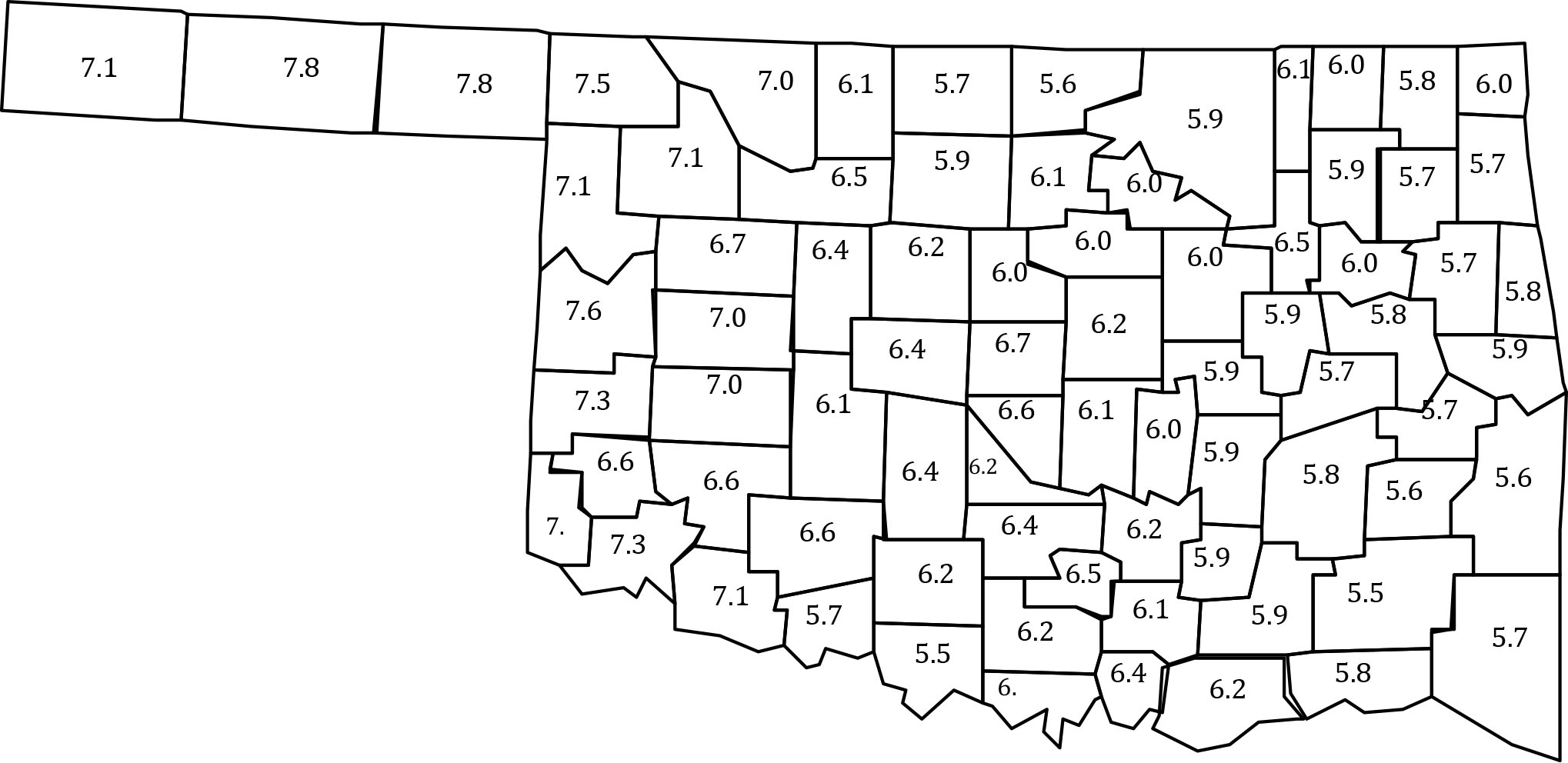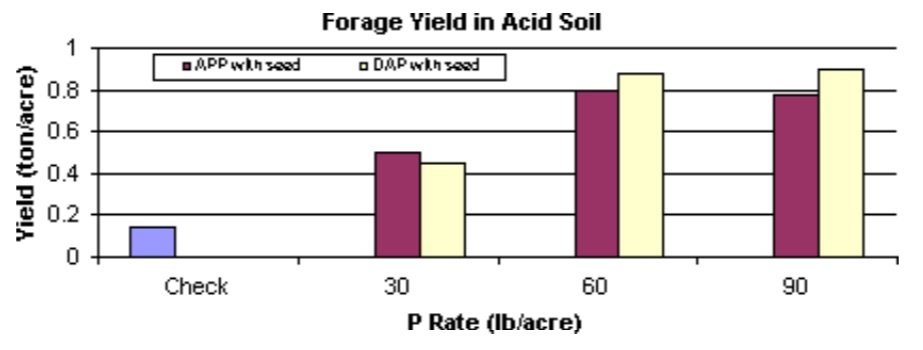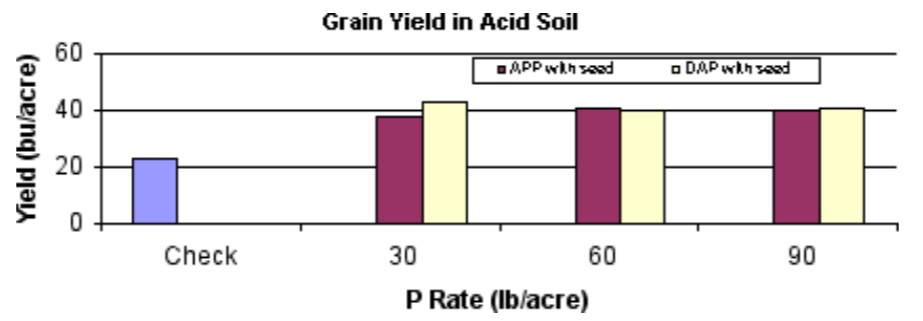Managing Acid Soils for Wheat Production
Soil acidity is a major yield-limiting factor for Oklahoma wheat production. Some of the most agronomically productive soils in the state have always been acidic, but the acidity has been sufficient to cause noticeable crop losses in recent years. High levels of nitrogen fertilizer used to produce high crop yields and the associated removal of lime-like elements has been a major factor contributing to soil acidity. Direct cost associated with liming has been the primary deterrent to correcting soil pH problems.
A summary of soil pH distribution in Oklahoma is shown in Figure 1. These data are from soil samples submitted to OSU Lab from 2009-2013. The median value for each county is presented, meaning that 50 percent of samples were higher than this value and 50 percent were lower. Twenty-four percent of all samples had a pH of less than 5.5 and indicated a potential production loss due to soil acidity.
OSU Extension Fact Sheet PSS-2239 describes how soils become acidic and the problem this causes in crop production. OSU Extension Fact Sheet PSS-2229 explains how soil acidity and the associated lime requirement are determined by soil testing. This fact sheet presents new information on the management of acidic soils for continuous wheat production, which might differ from acid soil management for other crops. Lower lime rates, for example, can be used in combination to wheat production, reducing production expenses. A short-term alternative to liming is banding of phosphate fertilizer with the seed, or planting acid-tolerant wheat varieties.

Correcting Soil Acidity
Lime Reactions
Soil acidity can only be corrected by neutralizing the acid present, which is done by adding a basic material. While there are many basic materials which can neutralize acids, most are too costly or difficult to manage. The most commonly used material is agricultural limestone (aglime). It is used because it is relatively inexpensive and easy to manage.
Limestone is easy to manage because it is not very soluble, meaning it does not dissolve easily in water. For this reason, it is not very corrosive to equipment, and more importantly, its pH at equilibrium (after it has dissolved as much as it can and some lime is still left in the water) is only about 8.2. This is very important because even an excessive application of lime will generally not result in a reduction of crop yields. As lime dissolves in the soil, calcium (Ca) from the lime moves to the surface of soil particles and replaces the acidity. The acidity reacts with carbonate (CO3) to form carbon dioxide (CO2) and water (H2O). The end result is neutralization of soil acidity. Figure 2. illustrates how lime rates and time after application affect soil pH.
Figure 2. Soil pH changes with time after lime was applied at 7 lime rates (tons/acre effective calcium carbonate equivalent) for 850 days. The calibrated full lime rate to raise the pH to 6.5 for this soil was 2.5 tons/acre ECCE.
Pelletized Lime
Pelletized lime or pell lime is often marketed to the farmer using the phrase “a few hundred pounds of this is equal to a ton of aglime,” but this is an inaccurate representation of the acid neutralizing potential of pelletized lime. Chemically, one molecule of CaCO3 will neutralize two H+ ions which are the cause of soil acidity. There is no shortcut around this reaction! Therefore, pelletized lime is no more effective in reducing soil acidity than aglime of the same ECCE (Effective Calcium Carbonate Equivalent). Pelletized lime is also often marketed to the farmer as a “quick fix” to pH problems. Field and laboratory experiments have repeatedly proven, however, that this is not the case and that pelletized lime does not neutralize soil acidity any faster than good quality aglime.
The primary benefit of pelletized lime products is the ability to apply these products with other fertilizer materials such as urea or DAP, thus eliminating an added pass across the field for lime application. However, due to the costs of materials, applying pelletized lime as an alternative to aglime is generally cost prohibitive.
Lime Research
Several field research experiments have been conducted to examine suitable liming materials and application rates. A common feature of all effective commercially available liming materials is that they contain a basic lime-like material such as calcium or magnesium carbonate. Since it is ultimately the material from which other basic materials are derived, aglime is usually the lowest cost per ton of active ingredient (ECCE).
A liming study on wheat was conducted in Garber, Oklahoma. Although wheat grain yields were slightly increased by liming, the relative wheat forage yields (three year average) increased significantly with lime rates up to 1.25 tons/acre (Figure 3). This increase of forage is significant for wheat farmers engaged in cattle production since most farmers in the central Great Plains use winter wheat for grazing during the winter and spring or for grazing and grain production. The estimated return to investment for liming acid soil indicates that all lime rates had a positive net revenue when lime rates were greater than 0.63 ton/acre. The half rate (1.25 tons/acre) had an impressive 269 percent rate of return in three years (Figure 4). In fact, the first year’s forage yield increase was sufficient to offset the liming costs, since the cost of liming was about $25/ac. and the value of the increased forage production was $27.6/ac (assuming $0.03/lb of dry wheat forage). The effect of liming would normally last more than five years; therefore, the potential economic return would be much higher than the cost of liming at the end of the third year. This indicates that it is economical to lime acid soils for winter wheat forage or for dual purpose (grazing and grain) wheat production. Using only 1.25 tons ECCE, one-half the normally recommenced rate, was effective to correct the acidity problem for wheat production.


Aluminum or Low-pH Tolerant Wheat Varieties
Wheat varieties have been identified which are much more tolerant to low pH conditions than other varieties. In 1999 a trial was conducted near Enid where pH = 4.3, soil test phosphorus was very high, and no phosphorus fertilizer was applied. Varieties such as Jagger, 2137, and Ok101 yielded more than 45 bushels per acre while varieties such as Custer, Trego, and AgriPro Thunderbolt yielded less than 20 bushels per acre. Varieties also differ greatly in forage production under low pH conditions. Figure 5 illustrates how different wheat varieties respond to liming and low soil pH. In a field with initial pH of 4.6 in Eakly in 2001, the fall forage yield increase caused by liming was 105 percent with AgriPro Tomahawk, a variety rated as very susceptible to low pH, while Ok101’s forage yield was only increased 27 percent. As a result of such tests, wheat varieties are now categorized as 1 to 5, 1 being most tolerant to low pH and 5 being least tolerant for production under acid soil conditions. The most current ratings can be found in Extension Fact Sheet PSS-2142, Wheat Variety Comparison Chart, which can be found at osufacts.okstate.edu.

Lime Rates
Minimum Amounts
The amount of lime to apply depends on whether or not wheat is grown continuously or rotated with a legume. If wheat alone is grown year after year, it is necessary only to apply a rate of lime to raise the pH to slightly above 5.5 to avoid disease problems at higher pH. If legumes are sometimes grown on the field, then the pH should be raised to 6.5 or above. Thus for continuous wheat, the following recommendation is made: The minimum amount of lime to apply is 0.5 ton ECCE lime or 50 percent of the soil test deficiency amount required to raise the pH to 6.5, whichever is greater. An OSU soil test will identify these lime rates for wheat whenever the soil pH is below 5.5. Cautions should be applied when using lime recommendations from other laboratories.
Calculating Rates
Lime requirements are expressed in terms of ECCE. ECCE is provided as a guarantee from lime vendors who are registered to sell aglime in Oklahoma. The guarantee is obtained by an analysis of the lime by the Oklahoma State Department of Agriculture, Food and Forestry. There are two components of the determination by their lab. First, the purity of the lime is determined chemically. In this test, they analyze for the amount of CaCO3 or its equivalent in the lime material. Second, how finely the lime particles are ground is determined. The more CaCO3 in the material and the finer the particle size, the greater the ECCE. Good quality lime will have an ECCE value above 50 percent. Because aglime does not always have an ECCE of 100 percent, the amount required to provide a given amount of 100 percent ECCE must be calculated. The calculations to use are shown below:
Tons of ECCE required X 100 / % ECCE = aglime required
For example, let us assume that the available aglime was 65 percent ECCE, and the soil test indicated a need for 1.5 tons ECCE to raise the soil pH to the desired level. The calculations would be:
1.5 X 100 / 65 = 2.3 tons of aglime
So, 2.3 tons per acre of the 65 percent ECCE lime would have to be applied in order to get the 1.5 tons of 100 percent ECCE lime required to do the job.
Lime Applications
Because lime does not dissolve easily in water, it must be treated similarly to fertilizers that supply the soil with immobile nutrients like phosphorus. For lime to be most effective in neutralizing soil acidity, it must be thoroughly mixed with the soil. Therefore, growers considering switching to a no-till production system are strongly encouraged to correct any pH problems before beginning no-till wheat production. Since neutralization involves a reaction between soil particles and lime particles, the better lime is mixed with the soil, the more efficiently the acidity is neutralized. For this reason, wet materials (like that from water treatment plants) that cannot be thoroughly mixed with the soil are often less effective. Similarly, pelletized lime particles are too large to mix well with small soil particles. Attempts to mix these materials with soil often result in soil acidity being neutralized near the lime aggregates (or pellets) only, whereas acidity between aggregates remains unaffected. Once the proper rate has been determined and the lime has been spread to give a uniform application over the field, it is best to incorporate it with a light tillage operation such as disking. Disking can be followed by plowing, but care should be taken not to incorporate too deeply or the lime will be diluted by subsoil and be less effective. Lime rates are calculated on the basis of neutralizing the top six inches of soil.
Since the lime reaction involves water, the effect of lime will be very slow in dry soil. Even when everything is done correctly and the soil is moist, it often takes three to six months for a measurable change in soil pH to occur. For this reason liming for wheat production should be done as soon after harvest as possible. However, when the soil pH is extremely low, sufficient change may occur in just a few weeks and make the difference between being able to establish a wheat crop and having a failure.
Reducing Metal Toxicity Fertilizer Reactions
Phosphate in the soil has long been known to be less available to crops in some extremely acid soils because it reacts with aluminum and/or manganese, which are more soluble in acidic soils. When phosphate reacts with these metals, the compound formed is a very insoluble solid (such as aluminum phosphate). As a result, not only is the phosphate unavailable, but the aluminum and manganese are also unavailable. For these reasons, when phosphate fertilizers are banded with the seed at planting time, the harmful effects of toxic aluminum and manganese are greatly reduced, and near normal yields may be obtained. Figure 6 illustrates the benefit of this practice for both grain and forage production.

Phosphate Materials and Rates
Figure 6 also shows that a higher rate of phosphate may be needed in order to get maximum benefits for fall forage production. It is especially important to use the higher rate for forage production on soil that has a pH below 4.5. The use of phosphate fertilizer in this way does not change soil pH. Also, within a few months after all the phosphate has been “used up,” more aluminum and manganese may become available. While this may not affect the developed crop, it will affect the next crop in the seedling stage. As a result, phosphate fertilizer must be applied each year, whereas lime only needs to be applied every five to eight years.
When to Use Phosphate
As stated earlier, acid soil is best neutralized by adding aglime. However, seed-applied phosphate (either ammonium polyphosphate (10-34-0) or diammonium phosphate (18-46-0)) should be considered for acid wheatland soils when:
- the land is owned by someone else who will not give a long-term lease or pay some of the cost for liming;
- the soil acidity problem is discovered too late for lime application this season;
- the soil has a low soil test value for phosphorus.
It is important to remember that this use of phosphate fertilizer is very different from normal. Banding phosphate on acid soils benefits yield even when the phosphate soil test value is higher than the 100 percent sufficiency level (>65), not because more phosphate is provided to the plant but because metal toxicity is reduced. Also, it is important to remember that the soil continues to become more acid with time. Eventually lime must be added to the soil to neutralize the acidity. On the other hand, buildup of soil test phosphorus above crop needs may lead to increased phosphorus in the runoff.
Extension Soils Specialist
Extension Small Grains Specialist
Wheat Breading and Genetics
Soil Fertility Research


